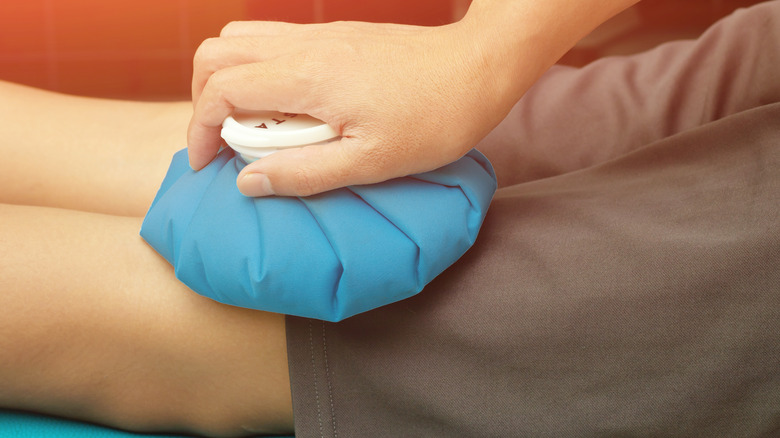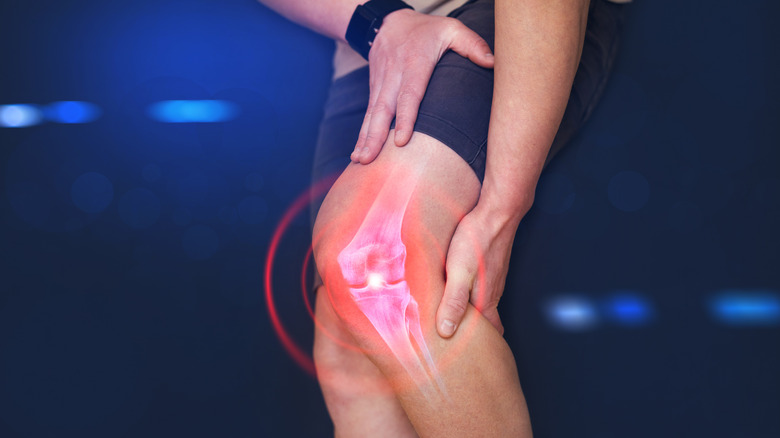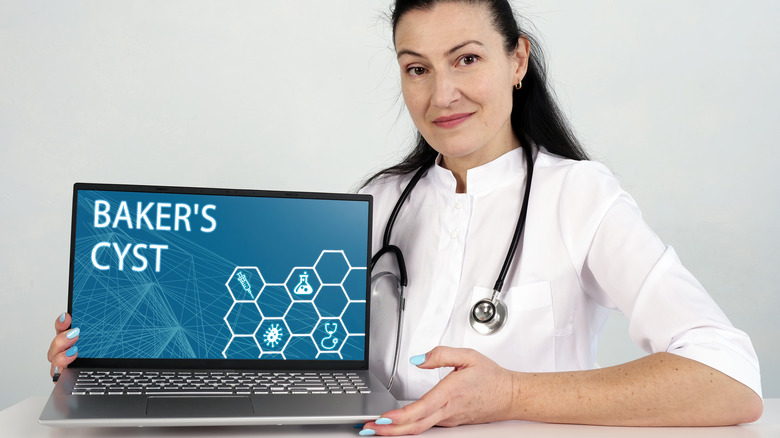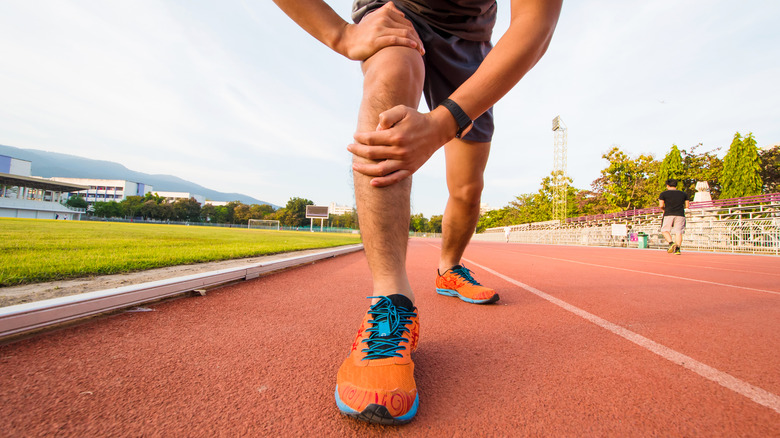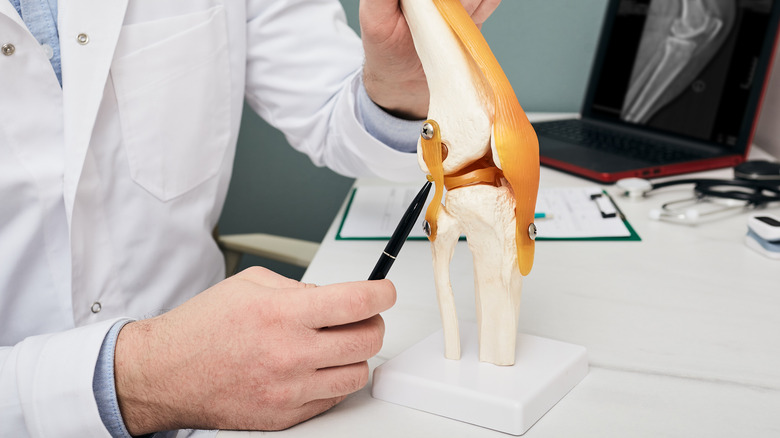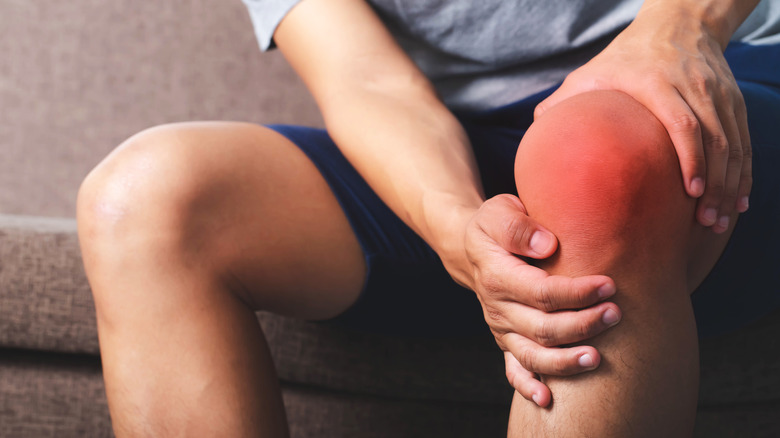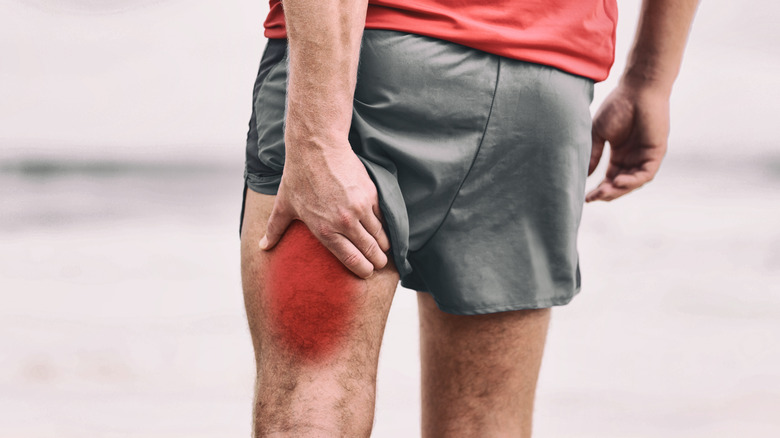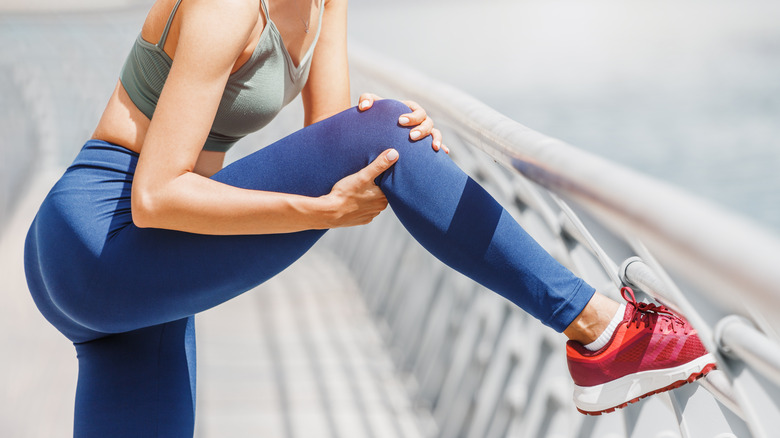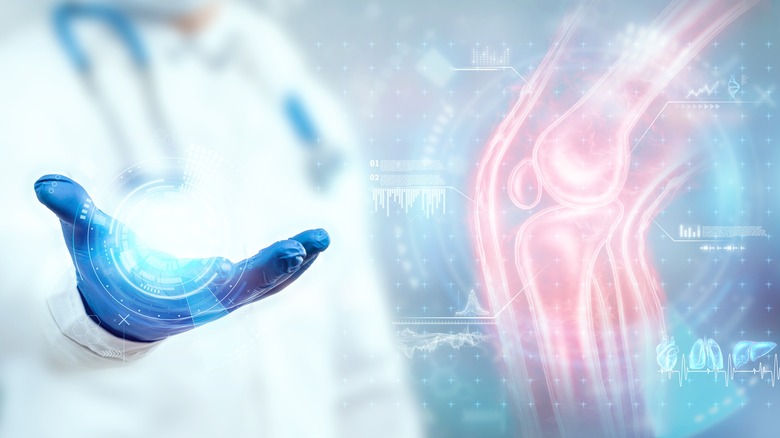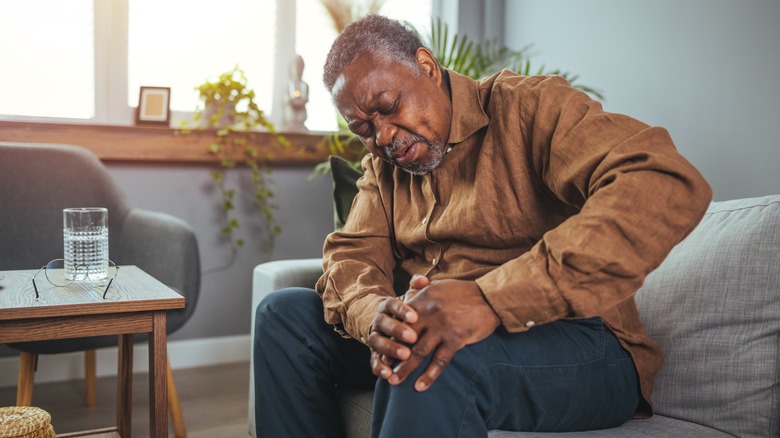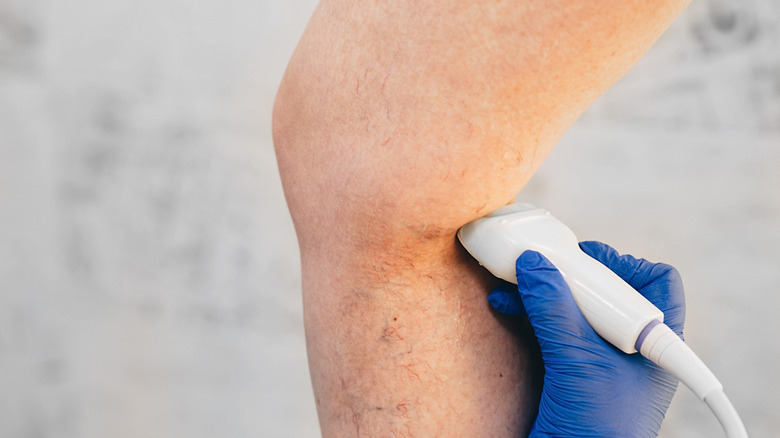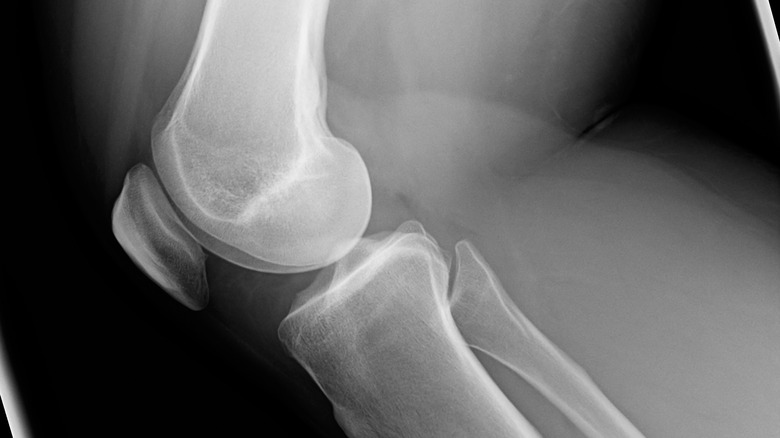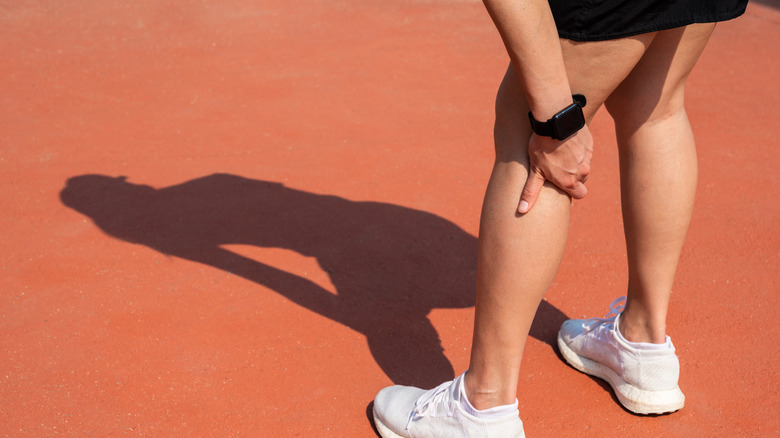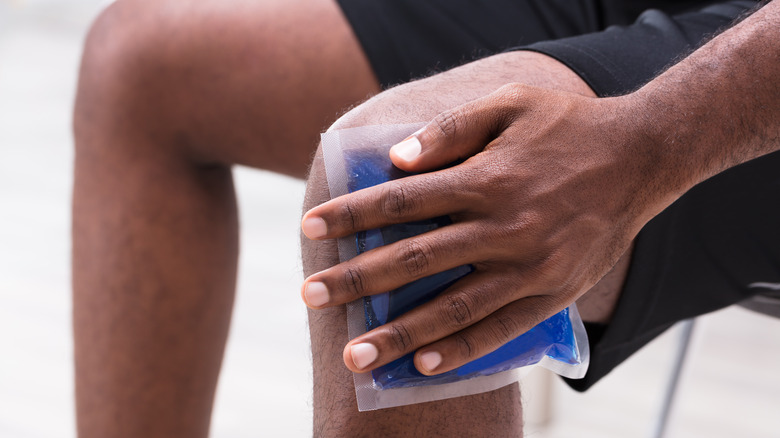12 Causes Of Pain Behind The Knee
It's our humble opinion that your knees are your best friends. (Sorry, actual real-life best friends. It's time to take a back seat, but we'll call you next time we need someone to help us move house.) The joints that reside in the middle of your legs are responsible for a range of movements and functions that contribute to basically every part of life. And when they're not operating at full capacity, that's when we truly notice how essential they are. Unfortunately, though, our knees not working entirely as they should happens pretty frequently, especially as we grow older, with 600,000 knee replacements taking place in the U.S. every year, according to Healthline.
To try and minimize your risk of knee injury or replacement, looking after your knees is essential. And in addition to maintaining a healthy diet and lifestyle, not overexerting your knee joints, and exercising regularly, you also need to watch out for any warning signs. Knee pain is a common symptom, but knowing how to diagnose it specifically may help you look after your joints properly, and give them the care that they need to stay working perfectly for years to come — and when pain occurs in the back of the knee, it can sometimes be a little tricky to figure out exactly what it is. That's why we did the hard work for you and put together a guide to the potential causes of pain behind the knee.
Cramp
Cramps are no joke, folks. From a dull twinge to searing pain, a cramp can strike anywhere, at any time. And it is particularly common in the back of the knee, where it could be the cause of your unidentified pain, according to Medical News Today. The pain that comes from the cramp behind your knee is a result of the muscles in the area becoming overly tight, but the cause of this tightness can vary hugely. As well as using your muscles too much, nerve damage or conditions, dehydration, an overabundance of toxins in your system, pregnancy, or tetanus can all instigate cramps in your legs.
Luckily, a cramp is a short-term condition, and while the pain experienced can be quite extreme, it usually won't last for more than a few minutes. You might find that regularly stretching the muscles that surround and make up the back of your knee, like your calf and hamstring muscles, may provide relief. Altering your walk by taking shorter strides may also cause less impact on your knees. If you're experiencing consistent cramps, though, it may be worth discussing your treatment options with a physiotherapist or doctor.
Baker's cyst
A Baker's cyst may have a quirky name, but we promise you there's nothing quirky about experiencing one — and if you have pain in the back of the knee, it may be down to one of these. Also known as popliteal cysts, Baker's cysts occur due to other damage to your knee, says the Mayo Clinic. When this damage (which may be due to joint inflammation or torn cartilage) happens, it may cause an unusual buildup of fluid, leaving you with a cyst that manifests as tightness and pain behind the knee, and difficulty moving your knee joint fully.
It's worth pointing out that Baker's cysts sometimes don't produce any pain at all, but if they do, it's important to seek medical attention. In a worst-case scenario, these cysts can pop, and when they do they can cause swelling and severe pain. If you notice any swelling around the back of the knee and suspect it could be from a burst cyst, contact your doctor immediately.
Runner's knee
Talk to any running enthusiast for more than five minutes, and they'll likely start to wax lyrical about their knees. When you run, your knees necessarily take on a lot of work, with the impact of each step moving through and being cushioned by them — and if your running form is poor, your shoes aren't supportive enough, or you're running frequently on hard, unforgiving surfaces, this impact can lead to injury (via Healthline). Over time, your knees can start to suffer from repeated running action (or any type of repetitive impact or stress to the knee, with activities as seemingly low-risk as walking potentially causing strain, says Healthline), and when that happens, you might have a case of runner's knee on your hands.
Characterized by a low-level ache, a runner's knee can be felt in any area of the knee, including the back. This can be felt during everyday activities, or even when you're doing nothing, with your knee at rest. You might also experience some slightly unsettling symptoms like grinding or popping in the knee joint. In most cases, you won't need any significant medical intervention to treat a runner's knee, and by using rest, ice, compression, and elevation (or RICE), as well as pain medication if necessary, it should clear up on its own. If your runner's knee is significant, though, or is due to cartilage damage, you may require further treatment.
ACL injury
Like other joints in our body, our knee is composed of a multitude of parts, including ligaments that allow the area to remain stable and keep the bones strung together. One of these, the anterior cruciate ligament (or ACL), runs through the middle of your knee joint and helps the area to rotate effectively and safely (via OrthoInfo). Occasionally, though, this ligament can become sprained through sudden movement or force to the knee joint. And when an ACL injury occurs, it can be pretty uncomfortable.
Generally, you'll notice the pain from an ACL injury immediately: Given that these injuries usually happen thanks to an unexpected movement, you might experience temporary weakness or limited range of motion in your knee, and a popping sound accompanied by pain. If this happens, the most important thing to do is discontinue any risky activity immediately. Trying to carry on with regular sporting activities, or in some cases moving around as normal, may further aggravate your symptoms. Your doctor may request an MRI to confirm an ACL injury (though it's typically not necessary), and treatment will be prescribed based on the severity of the damage, with a fully torn ligament requiring surgery to treat.
Patellar tendonitis
Our patellar tendon runs from our shinbone to our kneecap, and forms a large part of our knee, as Cedars Sinai shows. So when it becomes injured, we're pretty sure you'll know about it. Patellar tendonitis occurs when your patellar tendon becomes inflamed, which most commonly happens thanks to repeated impact or overuse of the joint during activities that involve jumping (which is why this condition is also called "jumper's knee"). And as you might expect, when injury presents itself, you may end up feeling a significant amount of pain, as well as swelling and sensitivity around the knee, including around the back.
Given that patellar tendonitis is similar in symptoms to a lot of other knee conditions, you'll likely need a trained medical professional to properly diagnose it. Your best course of action for recovery is to cease any strenuous activities immediately and rest the knee joint until the tendon is fully healed. Your healthcare provider may also request that you perform specific stretches or exercises to bring the area back to full health and strength.
Hamstring strain
The hamstring is one of the largest muscles (okay, it's actually three muscles) in your body, and provides a vital function to your knee, helping it bend (via WebMD). However, given the amount of stress we put our legs under on a day-to-day basis, it's little wonder that the hamstring can become injured fairly often. Hamstring strains occur when we've put the muscle through too much work, and it becomes overloaded and has trouble functioning correctly. We can feel a hamstring strain anywhere, including in the back of the knee, and although some strains may be mild, others may be completely debilitating.
Unfortunately, the only thing that will heal a hamstring strain is time and rest, with additional things like ice and elevation helping expedite the process. You're far better off knowing how to avoid a hamstring strain, so you don't get one in the first place. Before you exercise, make sure you're warming up the muscle properly, and cool down by stretching your hamstrings after you're done. Make sure you're not overdoing it on the exercise, too — as hamstring strains are caused by overuse, you need to listen to your body carefully and pull back at the first sign of muscle fatigue or injury.
Torn meniscus
The knee is good at many things, but rotating isn't one of its strong points. As a hinge joint, any rotation to the knee can cause it to become destabilized and injured, and this can impact and injure your meniscus, a small section of cartilage that sits between your bones and acts as a protective pillow (per the Mayo Clinic). Meniscus tears are pretty common, and the tricky thing is, you may not notice them immediately as you might with other knee injuries, with pain sometimes taking up to a full day to appear. When it does arrive, though, the pain will likely be most noticeable when you're applying any twisting motion to the knee.
It's worth bearing in mind, too, that in older adults, meniscus tears aren't necessarily caused by a sudden rotation. As the knee gets older and changes, the meniscus can become more susceptible to tears and injury. Meniscus tears can also increase your likelihood of developing arthritis further down the line.
PCL injury
Our knees are made up of an array of fascinating parts, and your posterior cruciate ligament (or PCL) is one of them. A small ligament that connects the tibia to the femur, your PCL keeps your bones in place, and your knee stable and functioning correctly (per Bupa). Now and again, though, our ligaments can incur damage, and pain behind the knee is usually one of the first signs of our posterior cruciate ligaments being in trouble.
This pain — and the severity of the damage — ranges from mild to severe, and PCL injuries can be pretty troublesome to treat. For the majority of people, however, a course of physiotherapy will be sufficient to clear up any symptoms after a PCL injury. It's important to remember that, far from being an isolated part of your body, the knees are heavily dependent on the strength and function of your legs to work properly, so your physio may well recommend exercises that strengthen your quad muscles. Bear in mind that the road to recovery with a PCL injury may be longer than you think — anywhere from a few months to a year — and that physical therapy will be recommended in some cases. It's worth it, though, to avoid further complications.
Osteoarthritis
While many incidences of pain behind the knee are caused by sudden injuries, others are slower — and may be something you have to deal with for life. Such is the case with osteoarthritis, which is highly common in the knee joint (per Versus Arthritis). When our joints become damaged successively throughout our lives, there comes a point when the body can no longer repair them. When this happens, the cartilage that protects our bones from rubbing against each other starts to thin, meaning our bones become more impacted, and our knee joints become painful and less mobile.
Pain from osteoarthritis can impact you anywhere in your knee joint, including around the back of your knee. As osteoarthritis can't be cured, it's important to understand how best to manage the condition, and to make healthy lifestyle choices that can ease pain and encourage function. Exercising regularly, and prioritizing low-impact, joint-friendly activities like swimming are essential to maintain movement in our knees. It's also important to consider the day-to-day impact on your knees, and how you might reduce any additional strain they undergo, whether that's through changing activities, managing weight, or opting for different footwear that can cushion your feet and knees from hard impacts with the ground.
Popliteal vein thrombosis
Your knee is an intricately made mass of bone, muscle, ligaments, cartilage, and tendons. And for all of these things to work effectively with each other, they need a constant blood supply. However, when this blood supply is disrupted, it can cause a specific type of pain behind the knee, thanks to a condition called popliteal vein thrombosis (per WebMD).
Popliteal vein thrombosis occurs when your popliteal vein — a deep vein that runs through the back of your knee and thigh — develops a clot, resulting in your blood not being able to flow correctly. Not only is this painful, but in certain situations it can be extremely dangerous, leading to a pulmonary embolism. Frustratingly, popliteal vein thrombosis can manifest itself with similar symptoms to other behind-the-knee conditions like Baker's cysts, with redness, pain, and swelling being common features of both. That's why your doctor may require an ultrasound or MRI scan to identify the cause of the pain. If popliteal vein thrombosis is behind the pain, you must follow advice from your doctor regarding treatment to stop the problem from escalating.
Chondromalacia patella
The cartilage in our knees performs an essential job, serving to cushion the impact between the thigh and knee bones and prevent them from rubbing against each other (via National Health Service). Sometimes, though, this cartilage can weaken and break down, and when this happens, things can start to get painful, fast (per the Cleveland Clinic). This condition, known as chondromalacia patella, increases the direct contact and friction between the knee and thigh bones. This results in grinding and pain through the knee, particularly when it's put in a downward-facing movement like descending a staircase.
It's important to point out that while the effects of chondromalacia patella sound dramatic, in many situations it's possible to recover entirely from the condition. To do that, though, it's important to rest the knee as much as possible. A cold pack or over-the-counter pain reliever can mitigate symptoms, and you might also want to think about how you can alter your lifestyle to take pressure away from your knees. If your exercise regimen is especially impactful on your knee joints, for example, you may want to consider lower-impact activities.
Referred pain
Pain behind the knee can be a mysterious thing, and hard to diagnose. So what if we told you that the pain behind your knee may not actually be behind your knee at all? Mind blown yet? Don't worry, us too. As it turns out, pain that manifests itself in your knee may come all the way from your back, as referred pain that occurs as a result of your nerves (per Physio.co.uk). Nerves that run from your lower back to your knees can sustain damage in your lumbar spine, thanks to disc damage or arthritis, and the pain then pops up at the other end of the nerve. As if the body wasn't confusing enough.
Referred pain due to nerve damage can often be accompanied by loss of sensitivity, sensations of pins and needles, or a tingly, prickly feeling. It's important to diagnose and treat nerve damage as soon as possible. Adjustments to your posture may be made, and the area may be treated with muscle therapy, via manipulation or massage. Functional electrical stimulation (or FES) may also be used.
How can I treat pain in the back of my knee?
If the pain behind your knee is significant, it's vital that you seek medical attention to determine the right course of treatment. But what about in the first instance? How do you treat the knee pain that you've got right now, especially if it's down to a sudden injury or movement?
The first thing you need to do is, quite simply, stop moving (per Healthline). Resting your knee immediately after the pain is experienced is the best thing you can do, primarily to give your knee a rest and to avoid any further damage (via Better Health Channel). Your focus should then be on encouraging healing and reducing swelling as much as possible. Icing your knee throughout the day can bring redness and swelling down, as can elevating it. It's important to raise your knee above your heart when you're elevating the limb — this encourages the swelling to dissipate more than just raising it slightly (per Medical News Today). Compression equipment like bandages or straps are also super helpful to wear around your knee, to give you additional support, particularly when you have to move around. Crucially, though, if these methods do not solve the problem entirely, book in to see your doctor. They can guide you on your long-term options and how to avoid further problems.
